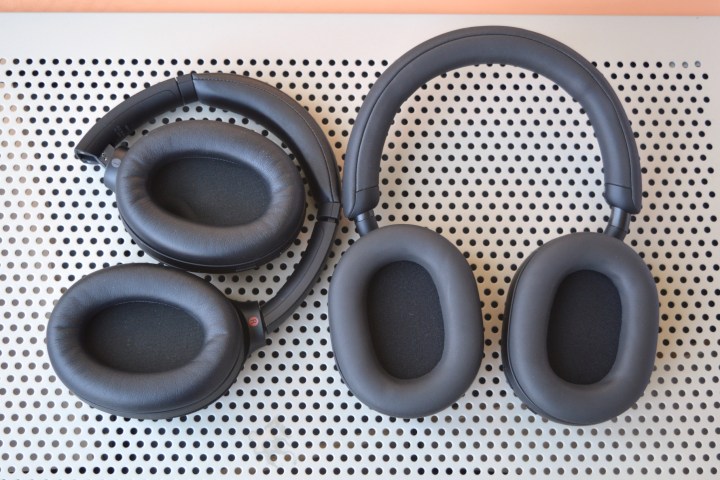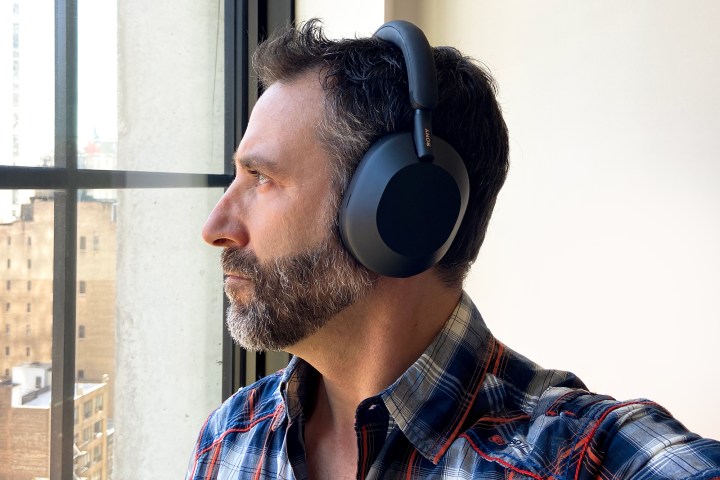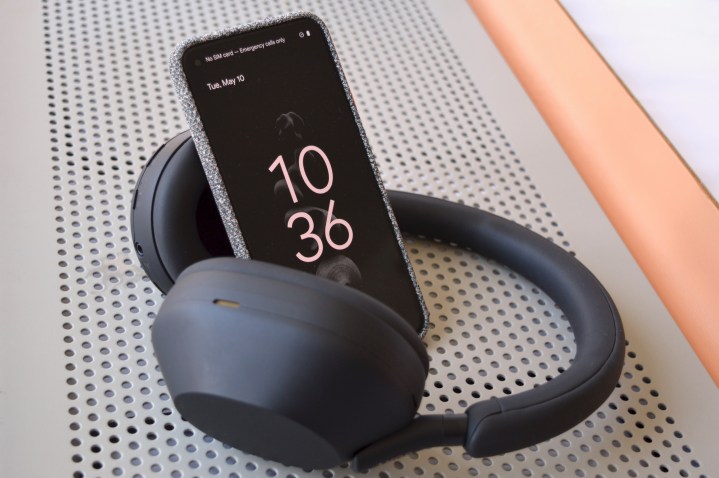- Excellent sound
- Very good comfort
- Ultra-clear call quality
- Best-in-class noise canceling
- Very good battery life
- Hi-res compatible (wired/wireless)
- Hands-free voice assistant access
- Classy, modern design
- Fold-flat, but don’t fold up
If you’ve been reading up on wireless and noise-canceling headphones over the last few years, you’ve likely noted the incredible praise that’s been heaped on Sony’s flagship, the 1000X series. Since its debut with the MDR-1000X — and through three follow-up models — it has consistently offered the best overall combination of sound quality, comfort, battery life, and noise canceling. When you then take into consideration the enormous number of extras Sony has thrown in over the years, like wireless hi-res audio, hands-free voice assistant access, quick attention modes, and rapid-charging, you’re probably left with the same conclusion that we came to: These headphones absolutely crush the competition, which explains why we awarded the fourth generation WH-1000XM4 a perfect 10/10 score.
With that kind of reception, you might think that Sony would take a breather, and maybe rest on its laurels for a while. Nope. We now have the WH-1000XM5, which Sony has decided to sell alongside the $350 XM4, but for $50 more. With a new, smaller driver design, more microphones, more powerful active noise cancellation (ANC) processing, and an elegant new shape, it’s clear that Sony thinks the XM5 offer lots of reasons to justify that extra $50. Do we agree? You betcha.
Video review
The best box

Before we get right into it, first a quick shout out to the folks responsible for Sony’s packaging. The XM5 come in the same ultra-recyclable plain cardboard containers that the company pioneered with the WF-1000XM4 wireless earbuds and then repeated with the LinkBuds. You won’t find a trace of plastic anywhere, and while buying consumer electronics might not be the best thing for the planet, at least you won’t be adding to your local landfill when you unbox your new cans.
As for what’s in that enviro-friendly box: You get the headphones, packed in their own zippered carry case. That case has its own magnetically closed compartment, where you’ll find the analog cable and, once again, a comically short USB A-to-USB-C charging cable. Wondering about an airplane adapter? Sony has apparently decided that if you still really need one, there are plenty on Amazon
Where have we seen this design before?

The XM4 only had two real challengers: Bose’s $399 Noise Cancelling Headphones 700, and Apple’s $549 AirPods Max. Those models gave the XM4 a real run for the money in both ANC and call quality. They also featured elegant designs, with single points of contact from the headband to the earcups. Sony’s design, while tried and true with its traditional fork-based earcup pivots, started to look a little old-fashioned — dare I say, even a bit boring.
Sony has managed to make the XM5 even more comfortable than the already excellent XM4.
Sony clearly looked to Bose and Apple for its XM5 inspiration. Gone are the classic flat metal headband sliders and earcup forks, replaced by one-piece tubular sliders that terminate in pivots hidden within the earcup housings. What stays is the slightly rubberized, matte-finish in your choice of black or what Sony calls “silver” (it’s actually more a sand color). Another change: The headband is now one continuous arc with padding on both sides, once again reminiscent of Bose’s design. It’s also a little narrower than the XM5.

The result isn’t a set of headphones that look smaller on your head — I’d argue the XM4 have a lower profile — but they do look thoroughly modern, even as they echo Sony’s now-familiar design cues like the bronzy-gold Sony logo and minimalist physical controls.
The one downside to Sony’s move into modernity is that the XM5 also suffer from Bose 700 and AirPods Max’s limitations: You can fold them flat, but you can’t fold them up, so they take up more room in a backpack or purse. And, when sitting around your neck, the earcups face “up” with the hard plastic of the outer shells resting against your collarbones instead of the ear cushions.
Comfort, controls, and connections

In addition to the design changes mentioned above, the XM5 are also the teensiest bit lighter than the XM4, clocking in at 8.81 ounces vs. the XM4’s 8.95 ounces. That doesn’t sound like much — and it isn’t — but, amazingly enough, you can feel it. I’ll be darned if Sony hasn’t managed to make the XM5 even more comfortable than the already excellent XM4, despite the narrower headband. Part of the reason is balance — the XM5 feel like they distribute their weight better. Another factor is the new ear cushion design, which is at once lower profile (which helps to keep the mass of the earcups closer to your head) and yet just as cushy.
These are all good things. But you may find — especially if your noggin is as small as mine — that the XM5’s clamping force isn’t as strong as the XM4. It’s not a problem for casual use, but if you like to be active in your headphones (something Sony specifically discourages on the attached warning label that features a big “no” sign over an image of a man sweating), you’ll notice that the XM5 move around a bit more.
The bottom line is that where once I would have picked the Bose 700 as the best wireless cans for long-term comfort, it’s now a dead heat between them and the WH-1000XM5.
- 1. Sony WH-1000XM4 (left) and WH-1000XM5
- 2. Sony WH-1000XM4 (left) and WH-1000XM5
- 3. Sony WH-1000XM4 (left) and WH-1000XM5
For the XM5’s controls, Sony’s mantra is “If it ain’t broke …” They’re identical to the XM4, with two dedicated power/Bluetooth and ANC/multifunction buttons on the left earcup, and a touch-sensitive panel on the outer surface of the right earcup. As before, they’re easy, accurate, and intuitive to use, and Sony has kept the awesome quick-attention feature which instantly replaces ANC with transparency mode when you cover the right earcup with your hand. The built-in wear sensor gives you fast and responsive auto-pause and resume for music, and it can be disabled in the app if you don’t need it.
As for music genres, take your pick. There aren’t any that won’t be an absolute joy to listen to.
I would have preferred if Sony had found a way to power up/down the headphones without needing a long-press of the power button, but there is some bittersweet news on that front. Sony heard from customers that the XM4’s spoken voice prompts were making actions like powering up and ANC mode switching too time consuming, so it has replaced some of them with just short audible tones. Unfortunately, if you liked the voice feedback, there’s no option to add them back in. That’s a pity because even after one week of use, I still find the tones harder to decipher. Voice feedback remains for low-power warnings and Bluetooth pairing.
The XM5 are equipped with Bluetooth 5.2, and as you’d expect, the wireless connection is rock-solid all the way up to its theoretical 32-foot range. With Google Fast Pair, they set up on Android devices in a flash, and even on an iPhone it’s pretty easy. You get Bluetooth multipoint for simultaneous connections to a phone and a computer (or any other two Bluetooth devices), but it’s worth noting that if you want that phone connection to use Sony’s LDAC codec — the highest quality wireless link you can get — you’ll need to forego the second device. Apparently LDAC and multipoint are mutually exclusive.
Sound quality

It’s unusual for a premium set of headphones to boast smaller drivers than its predecessor, but that’s what Sony decided to do. The XM5 are equipped with carbon-fiber-based 30mm dynamic transducers which are 25% smaller than the ones used in the XM4. The change allows for the lower weight of the XM5, but Sony claims they sound even better, too. And I agree. Mostly.
No beating around the bush: The WH-1000XM5 are the best noise-canceling headphones you can buy right now.
It all depends on how you define “better.” There’s no question in my mind that the XM5 exhibit greater subtlety and finer details, and the frequencies are beautifully balanced. At the same time, bass response is expertly managed, with a low end that does what low ends should do: Provide the thump, groove, and resonance that completes the musical picture, without dominating the other frequencies. The soundstage is open and airy and has the kind of precision that lets you build a map of the players and their instruments in your mind’s eye.
As for music genres, take your pick. I can’t think of any that won’t be an absolute joy to listen to. In short, they sound fantastic, especially when you engage the LDAC codec (Android only, sorry Apple users) and feed these cans high-quality content like lossless, hi-res audio from Apple Music, Tidal, Amazon Music, or your own ripped music.
But (you knew there was a “but …” coming), in delivering such a detailed and nuanced performance, Sony has taken a bit of a step back from the WH-1000XM4’s power and bass-forward signature. Like the drivers inside them, these two great headphones deliver two different sonic experiences. The XM5 will appeal most to those who seek a more neutral sound and who may have found Sony’s previous efforts too bombastic, while the XM4 continue to be the right choice for folks who like their tunes with a little extra punch.
As always, the Sony Headphones app gives you full manual EQ control should you wish to alter the factory tuning, and Sony provides several useful presets along with an independent bass boost adjustment. I like the default settings so much, I left these tweaks alone.
Noise canceling and transparency

No beating around the bush: The WH-1000XM5 are the best noise-canceling headphones you can buy right now. Thanks to the new eight-mic arrangement and dual-chip processing which enables real-time adaptive changes, the XM5 doesn’t just reduce some external noises — it erases them. It does this more effectively than the XM4, the Bose 900, and even the AirPods Max, which is really saying something, considering how good those other models are. You’ll hear the difference in a variety of situations, but the biggest improvement from the XM4 is the management of higher frequencies.
The degree to which the on-board processors are able to separate your voice from background noise is remarkable.
Sony says it’s especially helpful for dealing with voices, like the din in a coffee shop or restaurant, but I found it worked in almost every scenario I tried. The roar of a turboprop airplane engine was reduced to a whisper; Manhattan’s signature mix of traffic, construction, loud voices, and perpetual car horns were diminished to the point where my nerves weren’t frayed (my hometown of Toronto isn’t exactly quiet, but c’mon, nothing else is NYC). And these were the benefits when I wasn’t playing any music at all. Add some tunes — even at moderate volumes — and you might just convince yourself those external sounds aren’t there at all.
Sony has automated the process of optimizing ANC on the XM5 — on the XM4 it was done manually — so if you change the way you wear the headphones (adding or removing eyeglasses; changing hairstyles) or there’s an alteration in atmospheric pressure, there’s nothing you need to do. And you still have the option of using the Sony Headphones app to track your activity and locations to make changes to ANC and transparency as you switch up your day from sitting to walking to running, etc.
Transparency mode is also excellent, though if there’s one area where Apple maintains a slight edge, this is it. You’ll have an easy time hearing everything that matters, and the optional voice-enhancement mode does exactly what it purports to do. But somehow, the AirPod Max manage to convince you you’re not wearing headphones — something the XM5 fall just shy of achieving.
Switching between the two modes is fast and easy, whether you use the dedicated button for longer periods or the quick-attention gesture for short interactions.
Call quality

This is the other area where the XM5 handily outshines its predecessor and arguably the other competitors I’ve mentioned throughout this review. The degree to which the on-board processors are able to separate your voice from background noise — even when it’s very loud — is remarkable. They pull this off without the compression and muddiness that often accompanies this kind of algorithmic magic, and there’s only the slightest hint of harshness when the system is pushed to its limits.
Digital Trends Editor-at-large Caleb Denison and I both recorded voice samples in busy urban locations and we both experienced the same thing: Sounds that were super intrusive on our end, were seemingly non-existent when we listened to the recordings. Meanwhile, our voices sounded natural, with a pleasant, warm, tone. The only headphones that come even close are the JBL Tour One.
Battery life

Sony claims almost the same numbers for both the XM4 and XM5 — 30 hours of continuous playback with ANC on, and 38 (XM4) or 40 (XM5) when it’s off. From what I can tell, those numbers seem bang-on accurate. Sony doesn’t indicate how much of a hit these numbers will take when using LDAC, but based on my experience, you can expect it to eat up to 40%.
Either way, these stats are more than adequate for even the longest of flights. However, if you happen to own a USB Power Delivery (PD) charger, you’ll be able to quick-charge the XM5 with an extra three hours of playtime in a ludicrously fast three minutes. Yes, one minute equals one hour.
Our take
Sony’s latest noise-canceling flagship headphones come at a $50 premium over their predecessors, but the WH-1000XM5 justify that extra cost with a lot of extra performance and a slick new design. Do you need them? Probably not. Will you love them? Absolutely.
Is there a better alternative?
No. The Bose Noise Cancelling Headphones 700 cost the same amount, but can’t keep up with the XM5’s incredible sound, ANC, call quality and battery life, despite being very comfortable and a generally decent set of wireless cans. Apple’s pricey AirPods Max can go toe-to-toe on things like call quality, ANC, and transparency, but they’re heavy, have much lower battery life, and lack the amazing levels of detail and nuance you’ll get from the XM5, especially when LDAC is used.
That leaves the older WH-1000XM4. At $50 less, they’re still a good set of cans, but if you can find them cheaper — as I suspect you will over the coming months — they could prove to be a fantastic value. With a bigger, bolder sound signature, you might even prefer them to the XM5.
How long will they last?
Always a tough question, but Sony builds excellent products, and the WH-1000XM5 look like they will stand up to some pretty heavy use. I recommend keeping them away from sweat and rain as they don’t have any kind of IPX rating. If you do so, I expect you’ll still be enjoying them many years from now. Sony backs the WH-1000XM5 with a standard one-year warranty.
Should you buy them?
Yes. Sony charges a premium price for the WH-1000XM5, but you get a product that’s premium in every way, and for now, they’re the best wireless headphones you can buy.













